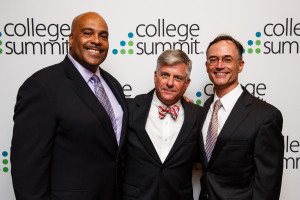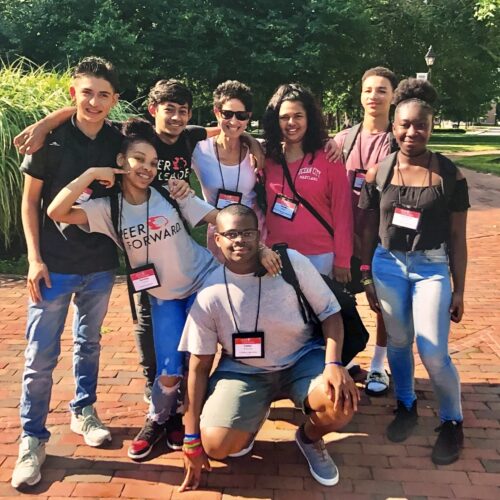Last week, President Obama signed the Every Student Succeeds Act (ESSA) into law. There is a provision found deep in the guts of the legislation that my PeerForward co-Founder, J.B. Schramm, with the help of PeerForward board members, have been building a coalition around for a decade now that it’s been signed into law, will begin to change the face of American education. Under the minimum requirements for State educational report cards, the bill stipulates that, where the data is available, each State must report the post-secondary enrollment rates for every high school, both in the aggregate and for each sub-group. Senator Capito (R-WV) and Senator Durbin (D-IL) are to be applauded for co-sponsoring the original language of the bill and working with their colleagues to gather support for adoption.
This clause in and of itself is cause for celebration. We have finally reached consensus as a nation on the post-secondary purpose of the American high school. High school graduation is now a milestone on the way to matriculation; it is no longer the endpoint.
Let’s be clear about what we mean by “college.” When we hear the word “college,” some of us envision a leafy 4-year campus adorned with brick buildings, tweed-clad professors, and strolling students with time to read, reflect, and yes, play. It is important to note that the term “college” encompasses so many more post-high school learning opportunities. “College” now refers to “any post-secondary educational experience with value in the marketplace.” As the National College Access Network (NCAN) puts it, college is “education beyond high school.” College does not even necessarily refer to a campus or a physical site anymore as distance learning is now commonplace. If the term “college” simply refers to a degree or certificate-granting institution or organization a student attends after high school, then high schools that have a “college-going culture” are structured and managed on the expectation that all students will go to “college,” so defined, and that college-going results will be measured and published for the purposes of constant improvement.
Increasing the post-secondary success rates for all of America’s students is essential for academic achievement, individual health and well-being, and economic reasons.
1. Academic performance increases when high schools set the goal of college success for all students.
When school leaders emphasize post-secondary preparation and matriculation over mere high school graduation, drop-out rates reduce and academic performance increases. Why? In a school with a college-going culture, students understand the relevancy of high school to their future. They are able to “connect the dots” between their studies and their hopes, dreams and aspirations. Students who do not complete high school or are considering dropping out tend to report that they just did not see the point of going to college.[1] In addition, these students said that, while they were in school, they never had the chance to connect with a caring adult or peer who was college positive and college savvy. High Schools dedicated to launching all of their students to career and college success – what we have called “Launchpad High Schools” and what we can now call ESSA schools – measure their success on post-secondary attainment and enjoy structures that help develop the kind of meaningful connection adolescents need to set goals and persevere through obstacles.
2. College Graduates lead longer, healthier, more fulfilling lives.
According to the Educational Longitudinal Study, college graduates live longer, smoke less, divorce less, report more job satisfaction, read more newspapers and engage in more community service and volunteer activities than high school graduates.[2] Why is this? For one reason, having a degree increases ones chances of securing better paying jobs with more health and retirement benefits. These jobs often come with a variety of learning experiences, professional development services and mentorship. Not to mention access to a more diverse peer group introduces one to new and different cultures, beliefs and world views. A college degree is ones gateway to be coming an informed and educated member of society.
3. The 21st century global marketplace needs more college-educated citizens with specific skill sets that, for now, are best obtained through post-secondary education.
In 2007, the National Center on Education and the Economy published a report entitled Tough Choices or Tough Times. The report presciently argued that the following factors were eroding our nation’s economic competitiveness: (1) technology was allowing more companies to hire skilled labor at a distance; (2) automation was extending to not only take the place of unskilled labor but more and more skilled, middle class jobs; and (3) critical steps in the production process were being outsourced. To remain competitive, the report’s authors argued that America has to increase its capacity to produce more college graduates who are creative, critical thinkers and intellectual synthesizers than our education system currently facilitates[3].
As we look ahead, economists forecast an even greater need for a college-trained workforce. Demand for workers with a college education will outpace the current supply by 300,000 openings per year. By the year 2018, there will be a million fewer college graduates than the labor market will need.[4] Given the current rates of college enrollment and graduation, colleges and universities will have to confer 10% more 4-year degrees each year to eliminate this shortfall by 2018.[5] When you include the need for 4.7 million additional workers with post-secondary certificates, our K-16 system will have to produce 7.7 million new post-secondary and college graduates by 2018.[6] These statistics – especially when combined with the educator’s vocational calling to tap the potential of every student who enters his or her school – serve as the clarion call to increase post-secondary achievement for all who are invested in the future of the country.
4. Conclusion
Establishing the goal of college attainment for all students reinforces the historic goals of American public education as well as supporting the needs of our democracy for a well-educated citizenry. As early as 1837, Horace Mann argued for more inclusive secondary and post-secondary education: “After the state shall have secured to all its children, that basis of knowledge and morality, which is indispensable to its own security; after it shall have supplied them with the instruments of that individual prosperity, whose aggregate will constitute its own social prosperity; then they may be emancipated from its tutelage, each one to go withersoever his well-instructed mind shall determine. At this point, seminaries for higher learning, academies and universities, should stand ready, at private cost, all whose path to any ultimate destination may lie through their halls.”[7]
We have a lot of work to do to get our kids to graduate from high school, prepared for the particular post-secondary training they will need to either thrive in the workforce or to create new and heretofore undreamt of career pathways. Until now, we could not manage, in a systematic way, this process without knowing how many of students make it to (and through) college.
Keith Frome, PeerForward CEO
[1] Bridgeland, John, Dilulio, John, and Morrison-Burke, Karen. Dropouts: Perspectives of High School Dropouts. Washington: Civic Enterprises, 2006.
[2] Ingels, S.J, Curtin, T.R., Kaufman, P. Alt, M.N. and Chen, K. (2002) “Coming of Age in the 1990s: The Eight-Grade Class of 1988 12 Years Later.” (NCES 2002-321). Washington, D.C.: U.S. Department of education, National Center for Educational Statistics.
[3]Ibid, p. 8.
[4] Carnevale, Anthony P., et. al., “Help Wanted: Projections of Jobs and Education Requirements Through 2018,” Georgetown University Center on Education and the Workforce, June, 2010, pg. 16.
[5] Ibid, pg. 18.
[6] Ibid.
[7] Mann, Horace. (1837) “First Annual Report” in The Republic and the School: On the Education of Free Men, ed. Lawrence Cremin. (NY: Teachers College Press, 1957), p. 33.












